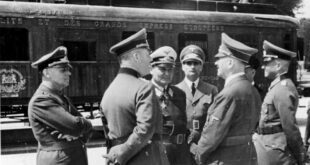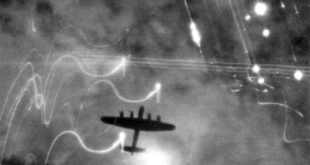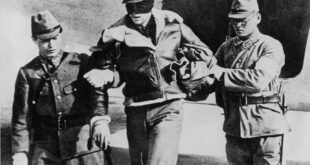From the architectural diversity of so many wonderful buildings, to grey communist standardization, the Romanian capital is a city which wears both its rich history and deep wounds on its sleeve. Having suffered heavy bombings at the hands of both Allied and Axis forces during the war years, Bucharest is a place with stories to tell. It is screaming them in the daylight, and whispering them in the shadows. You just need to make yourself aware.

With only a half broken smartphone in my pocket (talk about lowering expectations), I went on a Summer day walk so we can all see how some things have (or have not) changed since the times of World War Two in the metropolis which was once affectionately described as “The Little Paris”.
We start our journey on Calea Mosilor (Old Men’s Alley), one of the oldest and most historically significant streets in the city. Already a major artery from the times of medieval Bucharest, Calea Mosilor has been expanded over the years, and to this day it remains a major thoroughfare of the capital, although devoid of the glamour it may have had in previous ages. In 1825, Calea Mosilor was the first street in Romania to be paved with cobblestones.
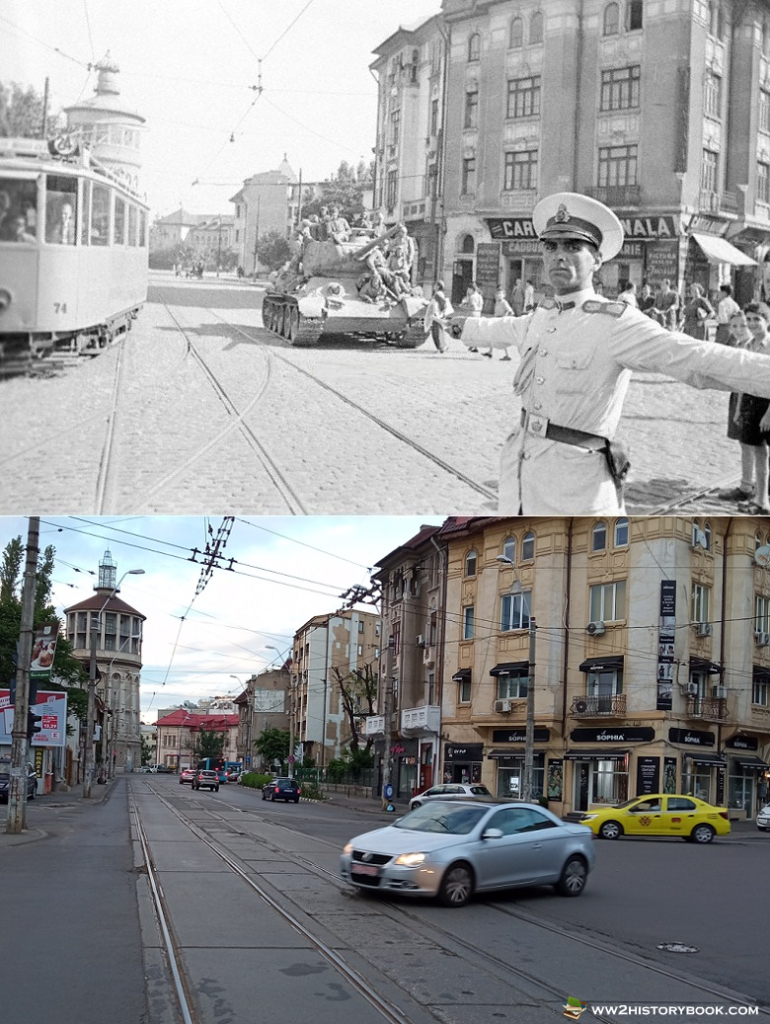
August 1944 vs July 2021. Soviet soldiers with a T34 tank during the Red Army’s occupation of Bucharest. Officer appearing to direct traffic. See the famous Fire Tower (“Foisorul de Foc”) still standing on the far left (in fact all historical buildings are still around). No more cobblestones.
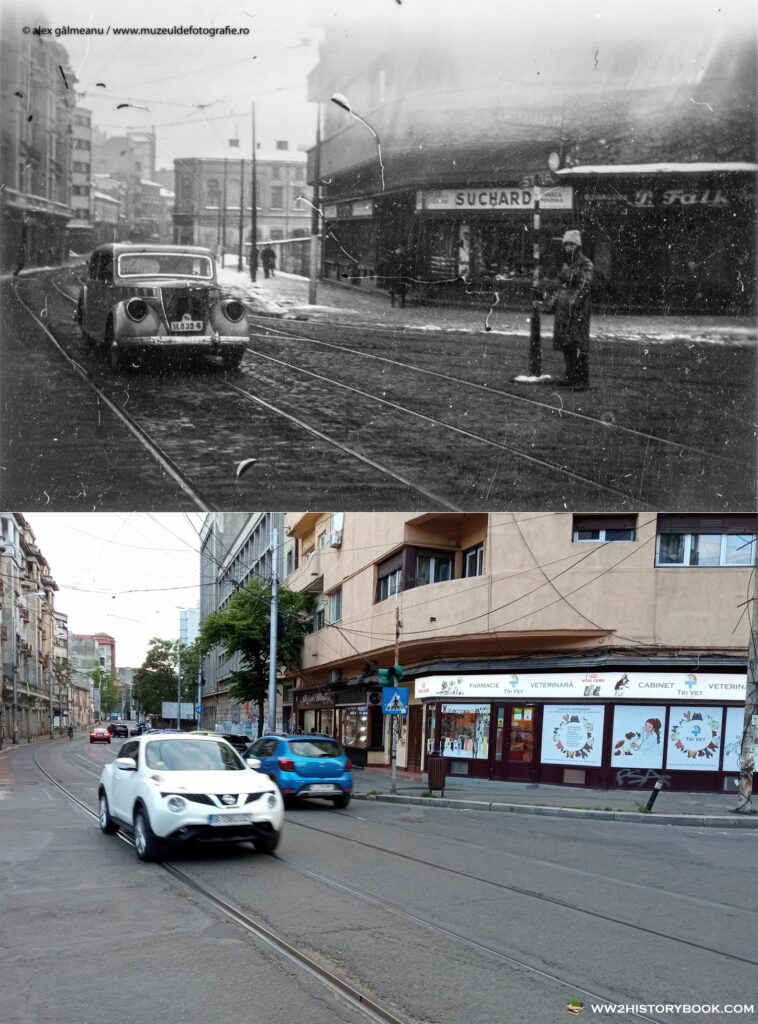
Hristo Botev – Mosilor intersection photographed by German soldiers sometime between 1940 and 1943 (in Winter, as suggested by snow), and now in July 2021. Most of the buildings on the left survived, as well as the first building on the right.
The end of Calea Mosilor brings us to Unirii Square, one of the most important transport hubs and points of interest in the center of Bucharest. This is an area which suffered massive transformations during the post-WW2 communist rule. Of course, those transformations have rarely been for the better.
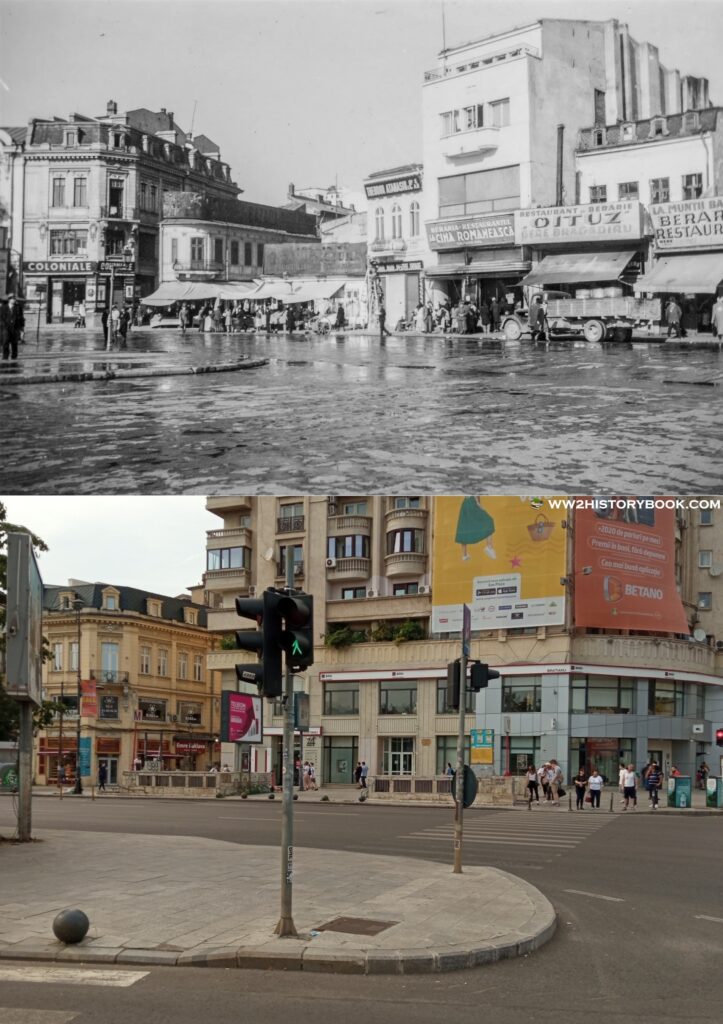
1942-1943 vs July 2021, Halelor Street and the French Street. The reference point here is the building on the left, the only one still standing. I couldn’t quite get the perfect angle due to this being a busy area, full off trees & traffic signs. Also, the orientation and architectural lines of the buildings on the right have changed.
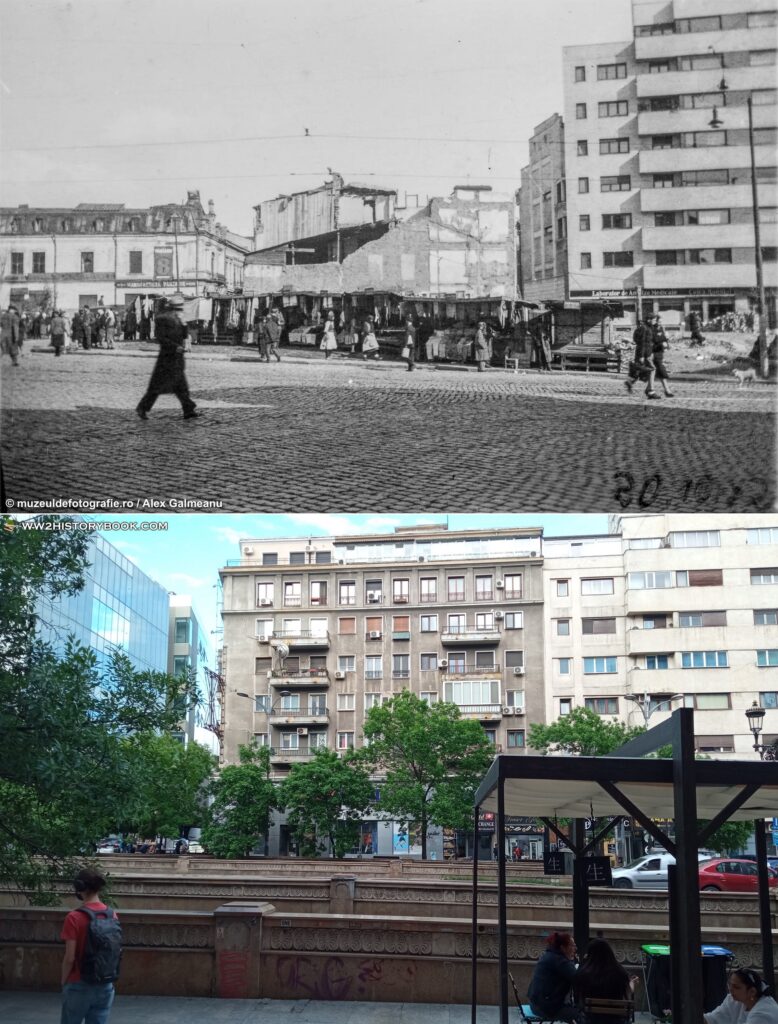
Bratianu Boulevard, October 1942 vs July 2021. The boulevard was not fully finished until 1943. So much has changed here. The Unirii underpass was inaugurated in 1987, while the not-so-popular ‘Cocor’ Shopping Center, slightly visible on the left, was opened in 2009. The apartment building in Art-Deco style on the right of the image is the only surviving structure in this photomontage.
No more than a few steps are needed, and we arrive at the very heart of Bucharest: Piata Universitatii (University Square). In the 1500s, the area used to be right at the northern outskirts of the city, but as Bucharest evolved and followed the Parisian influences of urban development, ‘University Square’ became both the geometrical center of the city, and the most important road junction. Statues and historical buildings intertwine with more modern architecture, watching the busy mob as people go about their daily lives.
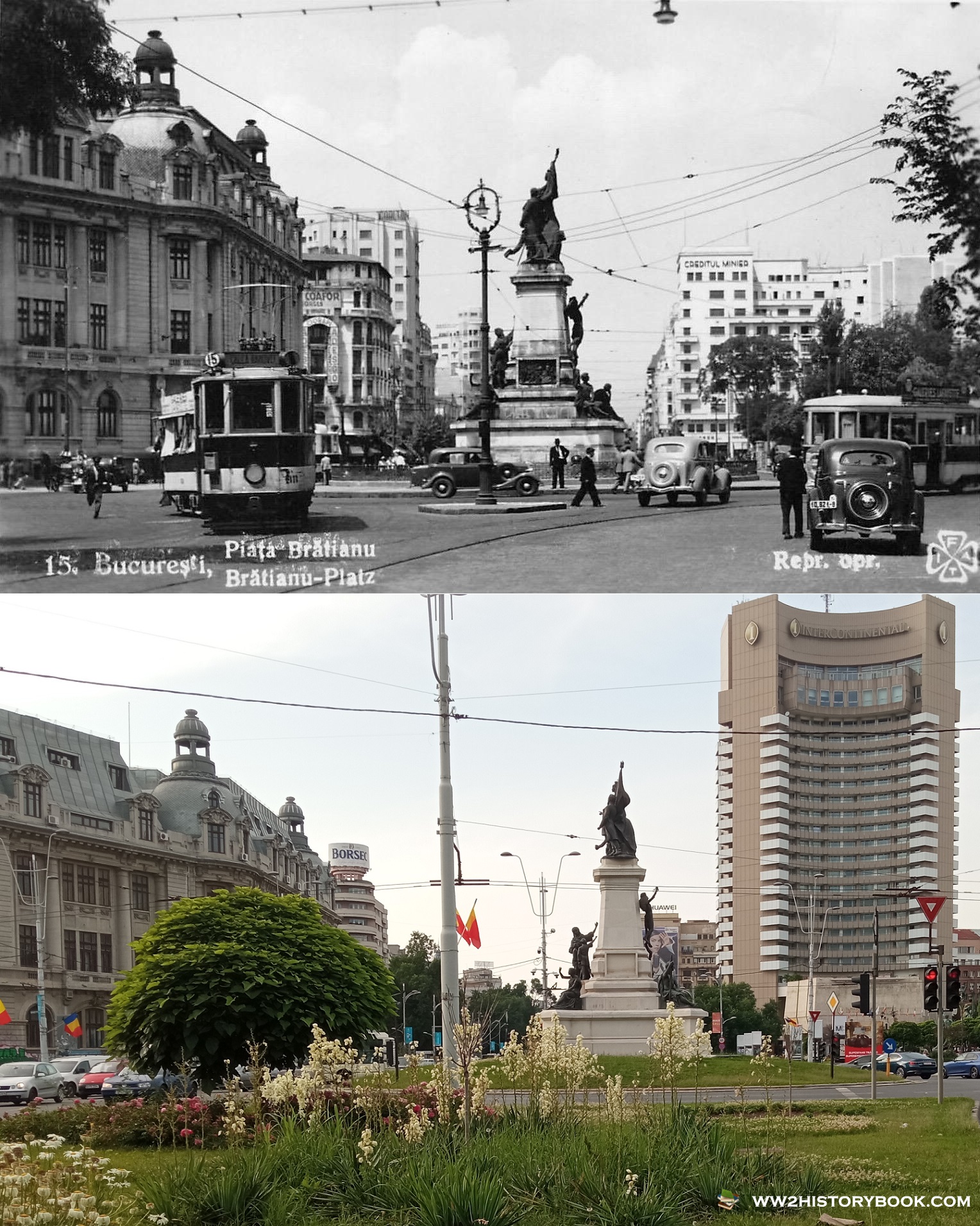
1939 vs. 2021. The area was also known as “Bratianu Platz”. The statue of I.C.Bratianu, prime minister during the Great War, still reigns over the square. On the left you can actually see a modification to the University of Bucharest’s structure (fourth floor, top-right of both images), after it was bombed in 1944. On the right, the Intercontinental hotel – it was built in 1971 and is still the tallest hotel in the capital. For the life of me I could not get the right angle on this, despite taking so many shots, so I’m sorry about that.
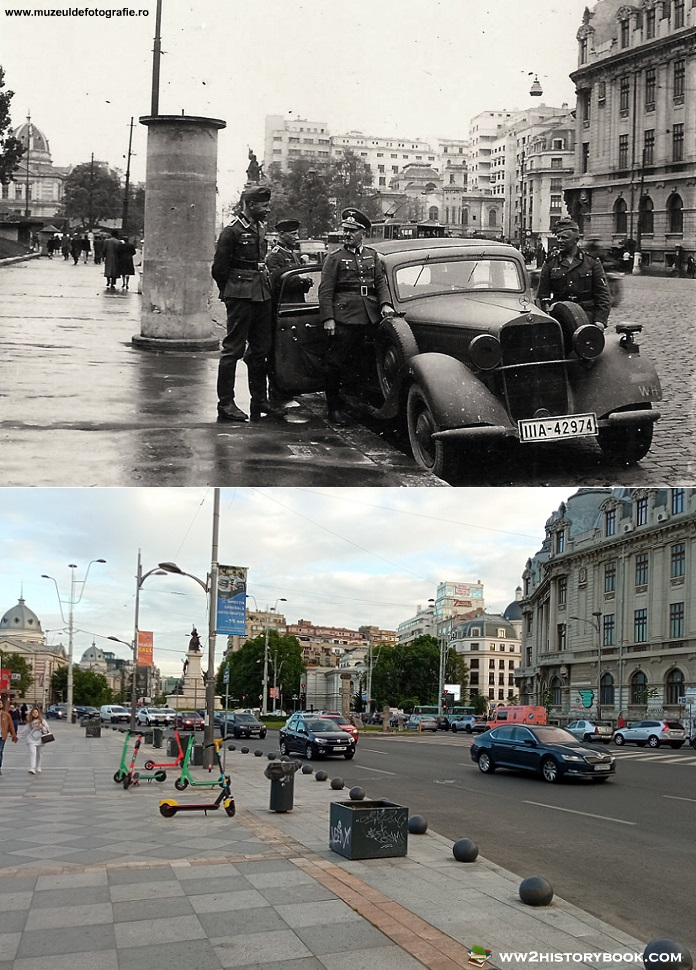
German soldiers and officers at University Square, sometime between 1940 and 1944, when Romania was part of the Axis forces. It’s hard to speculate who these persons were, but the man on the left of the Mercedes (highest ranked between them) seems to wear a Colonel (Oberst) uniform. Another remarkable thing about the image is the unchanged background. All these historical buildings have stood the test of time. So nice!
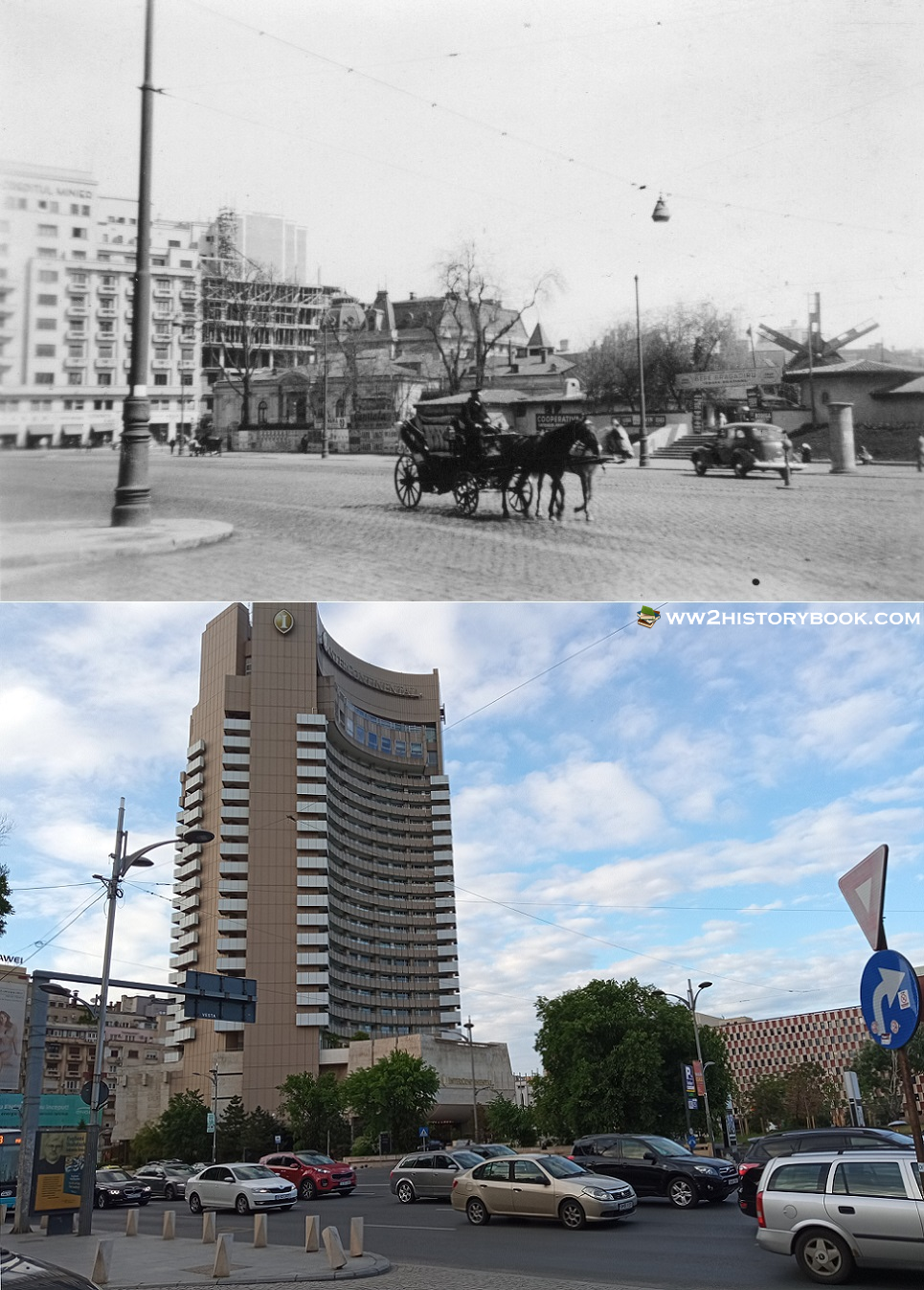
View of Magheru Boulevard from the Edgar Quinet street corner (1940 vs July 2021). The construction of the Intercontinental Hotel has changed the area so much. The apartment buildings behind the hotel still stand. On the right we see part of Bucharest’s national theater. It was re-built here in 1973, after being razed at its former location in August 1944 by Luftwaffe bombings, and was recently modernized. There’s a cute terrace on top now!

The University of Bucharest (built in 1864), pictured after the Allied Bombings of Bucharest in April 1944. Some sources suggest this image might have been taken after the German raids which took place later that year, but it seems more likely that US bombers caused this, in April. The University did not suffer huge damage and wasn’t reconstructed until 1969 (fully restored by 1980).
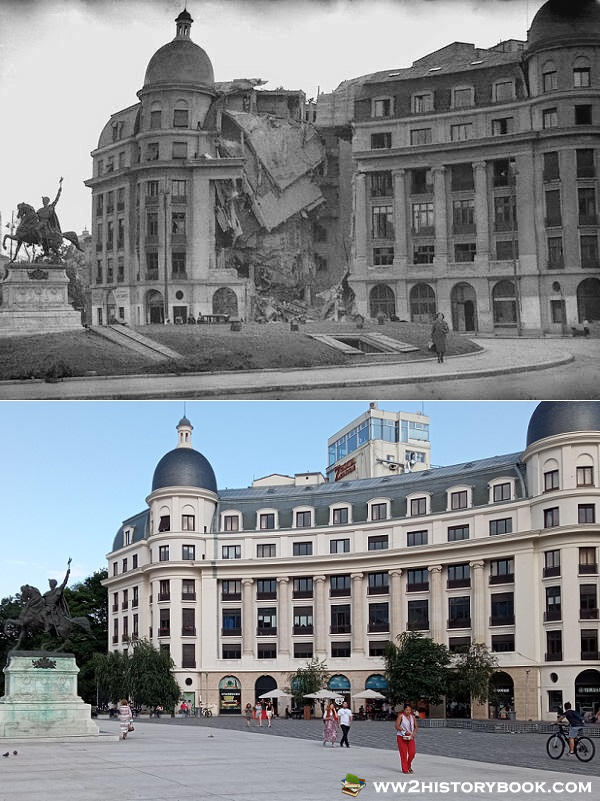
The Palace of Industrial Credit in University Square, which was also damaged by (likely) the US air attacks of April 1944, then rebuilt. On the left we can see the statue of Mihai Viteazul (Michael the Brave), prince of Wallachia between 1593 and 1601, still standing tall.
Just a bit further up the street, walking on Queen Elizabeth Boulevard, we reach Calea Victoriei (Victory Avenue). This is another famous street in Bucharest, filled with history and old buildings which survived the test of time. Calea Victoriei (named “Ulita Mare – Large Street” or “Brasov Road” before 1878, when it was given its current name after Romania’s victory in the Independence War) used to be a huge trade route and an area for promenade. Today it is a glamorous shopping strip, filled with cafes, shops, gelaterias and restaurants, and is a pedestrian area during the weekends. It has dedicated bicycle lanes (which is kind of a big deal in Eastern Europe) and is becoming an increasingly popular location between locals and tourists as we speak.
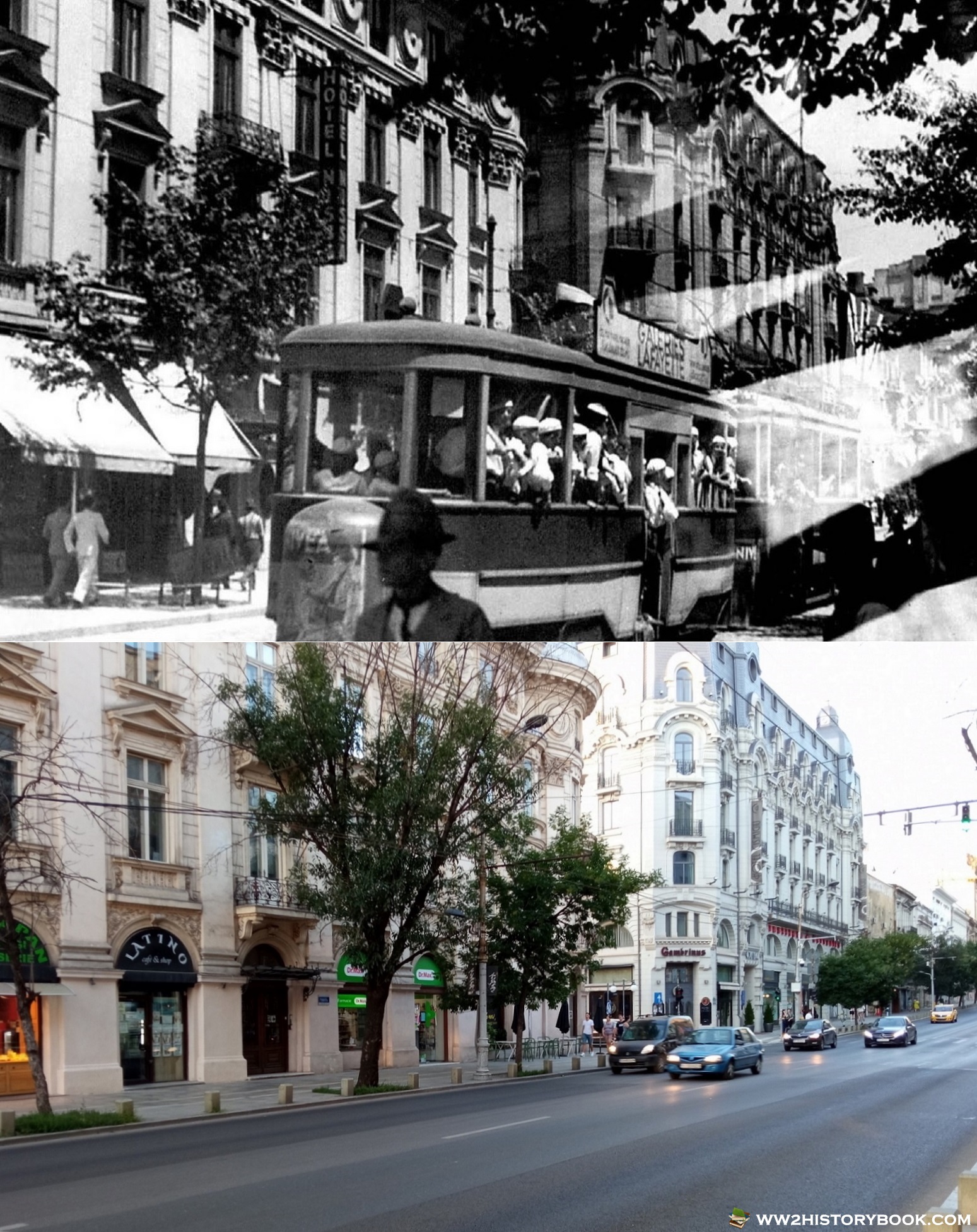
The art-nouveau style Hotel Cismigiu on Queen Elizabeth Boulevard (the building towards the right of the images) in the 1930s vs. July 2021. Notice how the tram is advertising Galeries Lafayette (on the top) and Nivea (front and midsection). Hotel Cismigiu, initially named “Palace Hotel”, was built in 1912 and nationalized by the communist regime in wake of World War 2, after which it was left in a prolonged state of degradation. In the early 1990s it served as a dorm for Theatre and Film students, until tragedy struck, as a Basserabian girl, Neli Bejan, fell into the elevator shaft and lost her life in a disturbing turn of events. Popular soft rock band “Vama Veche” launched the song called “Hotel Cismigiu” – a cover of “Hotel California” by The Eagles, depicting both college life and the sinister conditions of living in the hotel. The building was finally acquired by a Spanish company which restored it in 2012, and is now an appreciated 4 star hotel.

Entering Calea Victoriei from Queen Elizabeth Blvd. The buildings in the foreground of the historical image are no longer there. In the background of the historical image (and the foreground of the one today) we have Hotel Capitol on the left, and Hotel Capsa on the right, two gorgeous baroque-style buildings from the late 1800s / early 1900s. If you enlarge the image you might notice I marked the buildings with four colored dots, for better orientation and identification. The historical photograph was taken sometime in 1930s or early 1940s. It may be 1935-1938 because there seems to be a rally going on (notice some people doing the Nazi Salute), and between those years we had the right wing National Christian Party, which had some affiliation with the 1st building on the right. It might have been one of their rallies. Just an informed guess, based on my research. On the far left: the Bucharest Telephone Palace.
Strolling further down Victory Avenue …
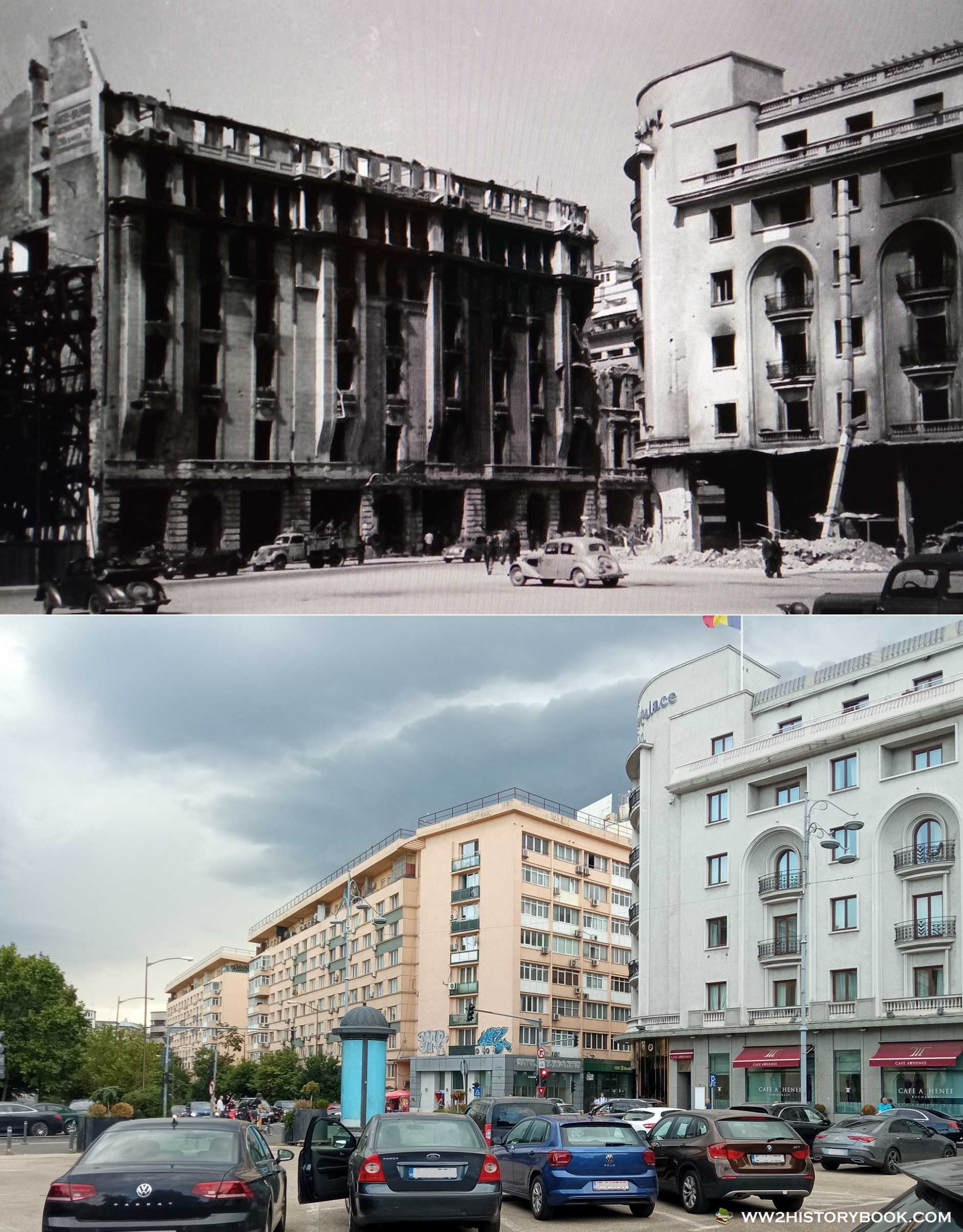
Athenee Palace Hotel (right) damaged by US bombings in the Spring of 1944, vs. July 2021. The first building in Bucharest to use reinforced concrete constructions, the Athenee Palace has quite a rich and glamorous history. It was described by Western journalists, before and during WW2, as a “meeting place of continental spies, political conspirators, adventurers, ladies of higher or lower virtue, concession hunters, and financial manipulators”, and as the “most notorious caravanserai in all of Europe”. The hotel was damaged and redesigned in different styles multiple times during its 100+ years history. The wrecked structure on the left did not survive, and was replaced by communist apartment buildings.
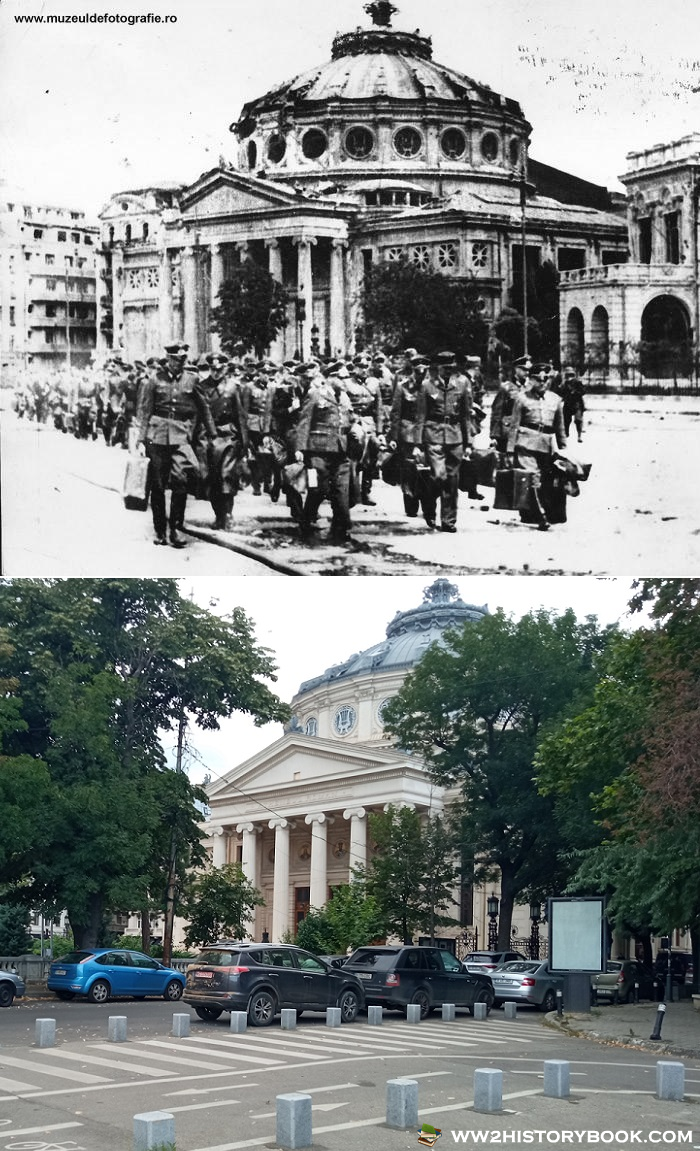
Wehrmacht soldiers are being escorted out of Bucharest after Romania joined the side of the Allies in August 1944. In the background, the famous Romanian Atheneum shows damage from Luftwaffe bombing raids, which occured just one day after Romania switched sides in the War (August 23rd, 1944). The romantical-neoclassical Atheneum has been restored and now stands strong, as seen in the second image.
Phew. It was a journey, but as the rain is starting to pour, it might just be time to head home. Bucharest certainly has many more stories to tell, as well as places to show, and maybe you will want to find those out for yourself one day. For now, I did my best to share a small, but significant part of Romania’s capital. And if you enjoyed this read, maybe I’ll do it again. Hopefully with a better camera, a bit more light and a bit more color! 🙂
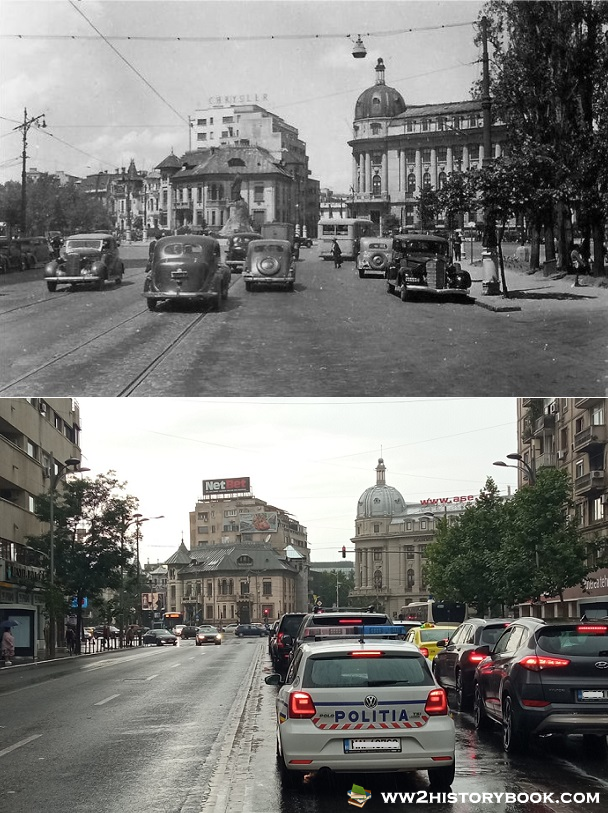
Romana Platz, in the Calea Victoriei / Piata Universitatii area, sometime in the early 1940s vs July 2021. The statue of Lascar Catargiu (Romanian conservative statesman from the 1800s), which used to reign over the square, has been removed by communists in the 1950s. There are new buildings flanking the Magheru Boulevard, but what we see in front of us is mostly unchanged, including the Bucharest University of Economic Studies on the right. Also: #FuckThePolice! 🙂
Historical photo sources:
• muzeuldefotografie.ro
• bucurestiivechisinoi.ro
• blog.alexgalmeanu.com
• turistinbucurestiro.blogspot.com
• wikipedia
– all “now” images are owned by ww2historybook.com
– unsourced historical images are believed to be public domain
– sourced historical images are believed to belong to the respective sources
– if you have a claim over any image believed to be public domain, please contact us and I will gladly mention the source or, if required, remove the photograph.
 WW2 HistoryBook World War II historical images. WW2 book reviews and movie reviews.
WW2 HistoryBook World War II historical images. WW2 book reviews and movie reviews. 